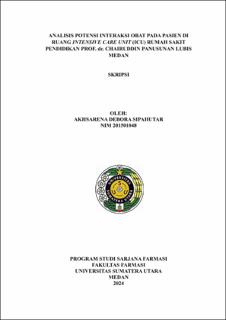Analisis Potensi Interaksi Obat pada Pasien di Ruang Intensive Care Unit (ICU) Rumah Sakit Pendidikan Prof. Dr. Chairuddin Panusunan Lubis Medan
Analysis of Potential Drug Interactions in Patients in The Intensive Care Unit (ICU) at Prof. Dr. Chairuddin Panusunan Lubis Educational Hospital in Medan

Date
2024Author
Sipahutar, Akhsarena Debora
Advisor(s)
Khairunnisa
Rambe, Rima Elfitra
Metadata
Show full item recordAbstract
Background: Potential drug interactions are events when the effects of a drug are changed due to co-administration with other drugs, herbs, food, drinks or chemicals from the environment. Potential interactions can occur through various mechanisms such as pharmacodynamics, pharmacokinetics and pharmaceuticals. The effects of this combination may manifest as augmentation or enhancement of drug effects, antagonism of drug effects, or other changes in the clinical effects of a drug. Potential drug interactions can occur due to the administration of more than one drug (polypharmacy) to patients. Administering drug combinations to ICU patients requires careful consideration to avoid unwanted side effects.
Objective: To determine the relationship between patient characteristics such as age, gender, number of diagnoses and number of drug uses per patient with the potential for drug interactions in ICU patients at Prof Dr. Chairuddin Panusunan Lubis educational hospital in Medan for the period June 2022-June 2023.
Method: The research method used was descriptive with a cross sectional design, data was obtained from medical records of ICU patients at the Educational Hospital Prof. dr. Chairuddin Panusunan Lubis Medan in the period June 2022-June 2023. Data was processed using Microsoft Excel and statistical analysis using IBM SPSS 22 software with T-independent or Mann-Whitney test, Pearson or Spearman's rho test. And potential drug interactions were analyzed using the Lexi-interact® and Stockley interaction drug checker instruments
Results: The results showed that from 146 patient medical records there were 4296 medication items with the highest characteristics of ICU patients, namely men (52.05%), aged 60-79 years (43.15%), main diagnosis of sepsis (14,38%) and cardiac arrest (14,38%), and a total of 4-6 diagnoses (29.46%). In this study it was also found that the fewest drugs given were 1 and the most were 24 with an average of 8,56 ±4,53 drugs per day per patient, according to age and gender 29.42 drugs per seven days length of stay, the dosage form most often given was via intravenous route (50.95%). ICU patients experienced potential interactions (74.66%) with the most common mechanisms of potential interactions being pharmacodynamics (50.18%), moderate severity (51.11%).
Conclusion: Based on the research results, it was found that the number of drugs had a significant relationship with the incidence of potential drug interactions, but age, gender and number of diagnoses did not influence the number of potential drug interactions that occurred in patients.
Collections
- Undergraduate Theses [1719]
